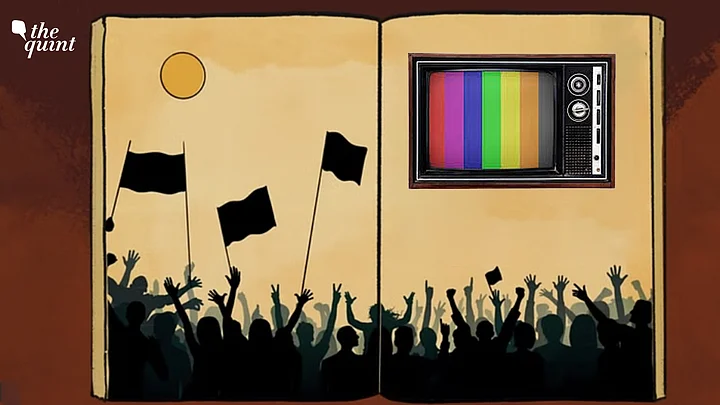Back in 1982, forty-one years ago, Indians celebrated the festival of colours Holi on 10 March. Less than two months after that, Holi visited Indian households once again in a symbolic yet powerful manner on 25 April, 1982.
Doordarshan, the state broadcaster and a monopoly, announced the test launch of colour TV services in the country.
India was all set to host the 1982 edition of the Asian Games and Indian families finally moved from blurred black and white telecasts to colour in all its technicolour glory.
That single move opened the floodgates for a new era of entertainment in the country. Within a few years, the legendary serial Hum Log made its debut in full colour on Doordarshan. Colour television has not looked back since then.
The Consumer Revolution
It was then when the Indian cricket team led by Kapil Dev humbled the mighty West Indies to win the World Cup. It had a massive and mesmerising impact when images of Rajiv Gandhi lighting the funeral pyre of Indira Gandhi flashed across a few million screens and persuaded Indian voters to deliver a massive mandate to the Congress party in the 1984 Lok Sabha elections.
As another column in October will show, the advent of private TV channels in 1992 had an even more transformative impact. Today, OTT platforms, streaming services, smartphones and high-speed internet promise yet another revolution. Besides, the Indian middle class has truly come of age since then.
When colour TV services were launched in April 1982, barely a few million households could boast of owning one in their drawing or living rooms. Forty years later in 2022, the burgeoning middle class of India purchased 40 million smart TVs. The baby steps that India took with colour TVs in April 1982 are now nothing short of a revolution.
Prime Minister Narendra Modi and his fans repeatedly assert that we now live in a New India. The authors would argue that a New India actually came into being way back in 1982. And it was not just the advent of colour TVs that heralded the birth of middle-class "consumerism”.
Construction and assembly line work at the Gurgaon-based factory of Maruti Suzuki was in full swing in 1982 and the first Maruti 800 rolled out in 1983. The “People’s Car” was a huge hit as it was a new form of mobility for Indians used to clunky Ambassador and Premier Padmini cars. The “red” Maruti-800 was all about the colour of life in the era of socialist grey. Of course, not many Indians could afford to buy even a Maruti. The real consumer revolution happened via two-wheelers.
For decades, the two-wheeler market in India was completely dominated by Bajaj Auto scooters. In 1982, the government allowed foreign automobile companies to form joint ventures with Indian entities and sell two-wheelers in India. All the major Japanese brands Yamaha, Suzuki, Honda and Kawasaki entered India and offered a dazzling array of choices to aspirational middle-class Indians who could afford a two-wheeler. The Bajaj Auto monopoly was destroyed. Across sectors, new companies and brands challenged the giants. For instance, who can forget the manner in which the humble homegrown Nirma humbled the mighty Surf detergent?
The Advent of Private Markets Steered Economy & Lives
In many ways, it was not just colour TVs but modern refrigerators, fuel-efficient two-wheelers, suitcases, soft drink concentrates and more that heralded the arrival of a New India back in 1982. In yet another virtually forgotten story, the year also marked the beginning of the end of “hard socialism” in economic policymaking; a system where the “State” had a vice-like grip over the private sector. The then Maharashtra Chief Minister AR Antulay was embroiled in a cement quota allocation scam.
The authors still remember those days when you had to “persuade” a government official to approve your “quota” cement to be able to build a house. The government had “fixed” cement prices at Rs 30 per bag while the actual “black market“ price was Rs 150 per bag. Shortages and corruption were rampant.
The then Prime Minister Indira Gandhi not only sacked Antulay, but her government also announced partial decontrol of the cement industry. Within a few years, production multiplied manifold, shortages disappeared and actual market prices crashed from Rs 150 per bag in 1982 to about Rs 40 per bag.
For the first time in decades, Indians realised what markets and competition could do when it comes to helping even average citizens. The stranglehold of the old system that enriched a few corrupt officials and politicians was so heavy that most Indians could not even think of a private company operating freely without stifling government controls. But the clamour for market forces and competition started growing louder. It took the Indian economy to face bankruptcy in 1991 before those controls were removed.
More than two-thirds of Indians are less than 35 years of age. For them, such historical vignettes like the arrival of colour television are some esoteric anecdotes dating back to some “ancient” times. One can’t blame the young. So used are they to using smartphones that they forget only 20 million Indians had access to a phone when the 21st century arrived. Today, 1,100 million Indians have access to a phone. But for the ageing generation, such historical trivia was a transformative moment in their lives.
(Yashwant Deshmukh & Sutanu Guru work with CVoter Foundation. This is an opinion piece and the views expressed are the authors' own. The Quint neither endorses nor is responsible for them.)
